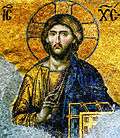List of Patriarchs of Antioch
| Part of a series on |
| Eastern Christianity |
|---|
 |
|
Liturgy and worship |
|
The Patriarch of Antioch is one of the original patriarchs of Early Christianity, who presided over the bishops of Syria, Palestine, Armenia, Georgia, Mesopotamia, and India.[1]
Patriarchs of Antioch
- Apostle Peter
- Evodius (ca. 53–ca. 69)
- Ignatius (ca. 70–ca. 107), who was martyred in the reign of Trajan. His seven epistles are unique sources for the early Church.
- Heron (107–127)
- Cornelius (127–154)
- Eros of Antioch(154–169)
- Theophilus (ca. 169–ca. 182)
- Maximus I of Antioch (182–191)
- Serapion (191–211)
- Asclepiades the Confessor (211–220)
- Philetus (220–231)
- Zebinnus (231–237)
- Babylas the Martyr (237–ca. 250), who,according to Nicephorus,[2] was martyred in the reign of Decius.
- Fabius (253–256)
- Demetrius (256–260), who was taken captive by the Persians under Shapur
- Paul of Samosata (260–268) supported by Zenobia, deposed by Emperor Aurelian; in Paul's time Lucian of Antioch was head of the Antiochene catechetical school[3]
- Domnus I (268/9–273/4) supported by Emperor Aurelian
- Timaeus (273/4–282)
- Cyril I (283–303)
- Tyrannion (304–314)
- Vitalius (314–320)
- Philogonius (320–323)
- Eustathius (324–330), formerly Bishop of Beroea, a steadfast opponent of Arianism; he was disposed in 327 and banished in 329. However, the adherents of the Nicene creed considered him the rightful bishop until his death.
- Paulinus I (330, six months), formerly bishop of Tyre, Semi-Arian and friend of Eusebius of Caesarea
- Eulalius (331–332)
- Euphronius (332–333)
- Flacillus or Facellius (333–342), in whose time renovations were made to the great church of Antioch, according to Nicephorus.
- Stephanus I of Antioch (342–344), Arian and opponent of Athanasius of Alexandria, deposed in 344.
- Leontius the Eunuch (344–358), Arian
- Eudoxius (358–359), formerly bishop of Germanicia, later (360–370) bishop of Constantinople, Homoian
- Anianus (359), immediately deposed
- Meletius (360—361), Semi-Arian, deposed in the reign of Valens for Homoiousian leanings
This deposition resulted in the Meletian Schism, which saw several groups and several claimants to the see of Antioch:
|
The Homoian group
|
The Meletian group The largest grouping, centred on the deposed bishop Meletius. It moved towards an acceptance of the Nicene creed and participated in the Council of Constantinople, but was not recognized by Alexandria or Rome:
|
The Eustathian group The followers of Eustathius, strictly adhering to the Nicene creed, elected the following bishops, who were recognized by the bishops of Alexandria and Rome:
After his death the Eustathians did not elect another bishop. In 399 they lost the recognition of Alexandria and Rome, but remained in schism until 415. |
The Apollinarist group
|
- Theodotus (417–428) (alternately 420–429)
- John I (428–442), condemned the First Council of Ephesus in the Nestorian controversy
- Domnus II (442–449), deposed by the Second Council of Ephesus.
- Maximus II (449–455), appointed by Emperor Theodosius II, accepted the Council of Chalcedon, deposed under unclear circumstances.
- Basil of Antioch (456–458), Chalcedonian
- Acacius of Antioch (458–461), Chalcedonian
- Martyrius (461–469), Chalcedonian, deposed by general Zeno
- Peter the Fuller (469/470–471), Non-Chalcedonian, appointed by general Zeno, deposed by Emperor Leo I
- Julian (471–476), Chalcedonian, exiled by Peter the Fuller
- Peter the Fuller (476), Non-Chalcedonian, restored by usurper Basiliscus, exiled by Emperor Zeno
- John II Codonatus (476–477), Non-Chalcedonian, who held the see only three months and was exiled
- Stephanus II (477–479), Chalcedonian
- Calendion (479–485), Chalcedonian, opposed the Henoticon, exiled by Zeno, replaced by Peter the Fuller
- Peter the Fuller (485–488), Non-Chalcedonian, restored by Emperor Zeno and condemned the same year (485) by a synod at Rome
- Palladius (488–498), Chalcedonian, accepted the Henoticon,
- Flavian II (498–512), Chalcedonian, accepted the Henoticon, deposed by Emperor Anastasius I.
- Severus (512–518), Non-Chalcedonian, appointed by Emperor Anatasius I, deposed by Emperor Justin I.
- Paul the Jew (518–521), Chalcedonian
- Euphrasius (521–528), Chalcedonian[4]
- Ephrem of Amid (528–546), Chalcedonian
The Syriac Non-Chalcedonians recognized Severus as the legitimate Patriarch until his death in 538. In 544, Non-Chalcedonian leader Jacob Baradaeus consecrated Sergius of Tella as bishop of Antioch, opening the lasting schism between the Syriac Church (which became part of the Oriental communion) and the Byzantine Orthodox Patriarchate of Antioch (part of the Eastern Orthodox Church).
Later patriarchs
For later Patriarchs of Antioch, see:
- Chalcedonian lines of Patriarchs:
- List of Greek Orthodox Patriarchs of Antioch 518 to present
- List of Melkite Greek Catholic Patriarchs of Antioch, covers 1724 to present
- List of Maronite Patriarchs 8th century to present
- List of Latin Patriarchs of Antioch from 1098 to 1964, when post was abolished
- Non-Chalcedonian lines of Patriarchs
- List of Syriac Patriarchs of Antioch from 512 to 1783
- List of Syriac Orthodox Patriarchs of Antioch, covers 1783 to present
- List of Syriac Catholic Patriarchs of Antioch, covers 1783 to present
References
- ↑ Walter Bauer, Greek-English Lexicon of the New Testament and Other Early Christian Literature, 2ed., 1979
- ↑ de Boor, Carl, ed. (1880). Nicephori Archiepiscopi Constantinopolitani Opuscula Historica. Teubner (Leipzig, repr. NY, Arno Press, 1975) pp.129–132. ISBN 0-405-07177-9.
- ↑ Suda On Line, Adler number: lambda, 685, retrieved 27 December 2008.
- ↑ Evagrius of Antioch, Hist. Eccles. 4.5, "he was crushed in an earthquake that destroyed the city in the seventh year, tenth month of the reign of Justin." However, Evagrius' date was wrong. See footnote in reference
External links
- Bishops and Patriarchs of Antioch
- List of Patriarch according to Syriac tradition
- Primates of the Apostolic See of Antioch (Greek Orthodox)